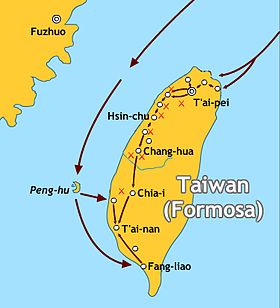
Back الغزو الياباني لتايوان (1895) Arabic Japonská invaze na Tchaj-wan (1895) Czech Japanische Invasion Taiwans German Invasión japonesa de Taiwán (1895) Spanish تهاجم ژاپن به تایوان (۱۸۹۵) Persian Japanin hyökkäys Taiwaniin 1895 Finnish Invasion japonaise de Taïwan French Tajvan japán megszállása (1895) Hungarian Invasi Taiwan oleh Jepang (1895) ID Invasione giapponese di Taiwan (1895) Italian
| Japanese invasion of Taiwan (1895) | |||||||||
|---|---|---|---|---|---|---|---|---|---|
 Japanese operations in Taiwan, 1895 | |||||||||
| |||||||||
| Belligerents | |||||||||
|
|
| ||||||||
| Commanders and leaders | |||||||||
|
|
| ||||||||
| Strength | |||||||||
|
7,000, rising to 37,000 by October 1895 around a dozen warships | 75,000 (ex-Qing regulars, local volunteers and Hakka militia) | ||||||||
| Casualties and losses | |||||||||
|
Killed: 333 Wounded: 687 Died from disease: 6,903[1] | Killed: 14,000 including civilian casualties | ||||||||
The Japanese invasion of Taiwan, also known as Yiwei War in Chinese (Japanese: 台湾平定, Chinese: 乙未戰爭; May–October 1895), was a conflict between the Empire of Japan and the armed forces of the short-lived Republic of Formosa following the Qing dynasty's cession of Taiwan to Japan in April 1895 at the end of the First Sino-Japanese War. The Japanese sought to take control of their new possession, while the Republican forces fought to resist Japanese occupation. The Japanese landed near Keelung on the northern coast of Taiwan on 29 May 1895, and in a five-month campaign swept southwards to Tainan. Although their advance was slowed by guerrilla activity, the Japanese defeated the Formosan forces (a mixture of regular Chinese units and local Hakka militias) whenever they attempted to make a stand. The Japanese victory at Baguashan on 27 August, the largest battle ever fought on Taiwanese soil, doomed the Formosan resistance to an early defeat. The fall of Tainan on 21 October ended organised resistance to Japanese occupation, and inaugurated five decades of Japanese rule in Taiwan.
- ^ “[Data in English is under preparation] 附録・附図” Japan Center for Asian Historical Records (JACAR) Ref.C13110299800, [Data in English is under preparation] 征台役 近衛師団の行動 北白川宮殿下の御遺跡 明治28.5.4~28.10.21 (National Institute for Defense Studies)